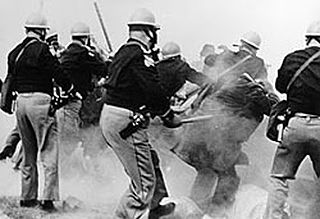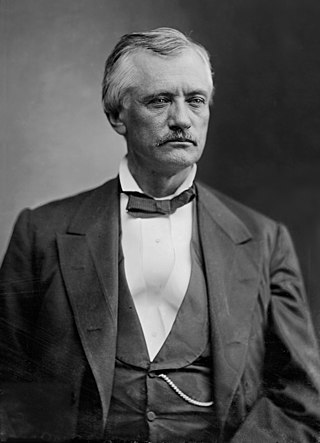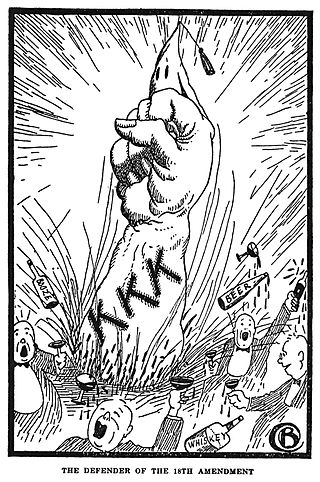
The Ku Klux Klan, commonly shortened to the KKK or the Klan in recent decades, is an American white supremacist, right-wing terrorist, and hate group whose primary targets are African Americans, Jews, Latinos, Asian Americans, Native Americans, and Catholics, as well as immigrants, leftists, homosexuals, Muslims, atheists, and abortion providers.

Selma is a city in and the county seat of Dallas County, in the Black Belt region of south central Alabama and extending to the west. Located on the banks of the Alabama River, the city has a population of 17,971 as of the 2020 census. About 80% of the population is African-American.

Edmund Winston Pettus was a lawyer and politician who represented Alabama in the United States Senate from 1897 to 1907. He served as a senior officer of the Confederate States Army, commanding infantry in the Western Theater of the American Civil War. After the war, he was politically active in the Ku Klux Klan, a domestic terrorist, racist and antisemitic organization, serving as a Grand Dragon.

The Selma to Montgomery marches were three protest marches, held in 1965, along the 54-mile (87 km) highway from Selma, Alabama, to the state capital of Montgomery. The marches were organized by nonviolent activists to demonstrate the desire of African-American citizens to exercise their constitutional right to vote, in defiance of segregationist repression; they were part of a broader voting rights movement underway in Selma and throughout the American South. By highlighting racial injustice, they contributed to passage that year of the Voting Rights Act, a landmark federal achievement of the civil rights movement.

Joseph Forney Johnston was an American Democratic politician and businessman who was the 30th governor of Alabama from 1896 to 1900. He later served in the United States Senate from August 6, 1907, to his death on August 8, 1913. As a senator, he was chair of the U.S. Senate Committee to Establish a University of the United States.

John Tyler Morgan was an American politician was served as a brigadier general in the Confederate States Army during the American Civil War and later was elected for six terms as the U.S. Senator (1877–1907) from the state of Alabama. A prominent slaveholder before the Civil War, he became the second Grand Dragon of the Ku Klux Klan in Alabama during the Reconstruction era. Morgan and fellow Klan member Edmund W. Pettus became the ringleaders of white supremacy in Alabama and did more than anyone else in the state to overthrow Reconstruction efforts in the wake of the Civil War. When President Ulysses S. Grant dispatched U.S. Attorney General Amos Akerman to prosecute the Klan under the Enforcement Acts, Morgan was arrested and jailed.

Viola Fauver Liuzzo was an American civil rights activist. In March 1965, Liuzzo heeded the call of Martin Luther King Jr. and traveled from Detroit, Michigan, to Selma, Alabama, in the wake of the Bloody Sunday attempt at marching across the Edmund Pettus Bridge. Liuzzo participated in the successful Selma to Montgomery marches and helped with coordination and logistics. At the age of 39, while driving back from a trip shuttling fellow activists to the Montgomery airport, she was fatally hit by shots fired from a pursuing car containing Ku Klux Klan members Collie Leroy Wilkins, Jr., William Orville Eaton, Eugene Thomas, and Gary Thomas Rowe, the last of whom was actually an undercover informant working for the Federal Bureau of Investigation (FBI). Although the State of Alabama was unable to secure a murder conviction, Wilkins, Eaton, and Thomas were charged in federal court with conspiracy to intimidate African Americans under the 1871 Ku Klux Klan Act, a Reconstruction civil rights statute. On December 3, the trio was found guilty by an all-white, all-male jury, and were sentenced to ten years in prison, a landmark in Southern legal history.
The Grand Wizard was the national leader of several different Ku Klux Klan organizations in the United States and abroad.

George Washington Gordon was a general in the Confederate States Army during the American Civil War. After the war, he practiced law in Pulaski, Tennessee, where the Ku Klux Klan was formed. He became one of the Klan's first members. In 1867, Gordon became the Klan's first Grand Dragon for the Realm of Tennessee, and wrote its "Precept," a book describing its organization, purpose, and principles. He was also a member of the United States House of Representatives for the 10th congressional district of Tennessee.
This is a partial list of notable historical figures in U.S. national politics who were members of the Ku Klux Klan before taking office. Membership of the Klan is secret. Political opponents sometimes allege that a person was a member of the Klan, or was supported at the polls by Klan members.

James Gardner Clark, Jr. was the sheriff of Dallas County, Alabama, United States from 1955 to 1966. He was one of the officials responsible for the violent arrests of civil rights protestors during the Selma to Montgomery marches of 1965, and is remembered as a racist whose brutal tactics included using cattle prods against unarmed civil rights supporters.

The Ku Klux Klan has had a history in the U.S. state of New Jersey since the early part of the 1920s. The Klan was active in the areas of Trenton and Camden and it also had a presence in several of the state's northern counties in the 1920s. It had the most members in Monmouth County, and operated a resort in Wall Township.
Events from the year 1821 in the United States.

The Edmund Pettus Bridge carries U.S. Route 80 Business across the Alabama River in Selma, Alabama. Built in 1940, it is named after Edmund Pettus, a former Confederate brigadier general, U.S. senator, and state-level leader of the Alabama Ku Klux Klan. The bridge is a steel through arch bridge with a central span of 250 feet (76 m). Nine large concrete arches support the bridge and roadway on the east side.
The U.S. Klans, officially, the U.S. Klans, Knights of the Ku Klux Klan, Inc. was the dominant Ku Klux Klan in the late 1950s and early 1960s. The death of its leader in 1960, along with increased factionalism, splits and competition from other groups led to its decline by the mid-to-late 1960s.
Anthony Dickinson Sayre was President of the Alabama State Senate (1896-97) and a justice of the Supreme Court of Alabama from 1909 to 1931. Sayre's daughter was Jazz Age socialite Zelda Sayre, the wife of novelist F. Scott Fitzgerald.

Old Live Oak Cemetery is a historic cemetery in Selma, Alabama founded in 1829 and expanded in 1877. The newer portion is sometimes called New Live Oak Cemetery and the cemetery is collectively known as Live Oak Cemetery. It contains burials of Confederate States of America leaders, as well Benjamin Sterling Turner, a formerly enslaved African-American who served as U.S. Representative for Alabama during the Reconstruction era. The cemetery is at 110 Dallas Avenue approximately 0.7 miles (1.1 km) west of downtown Selma.
John T. Morgan Academy, commonly known as Morgan Academy, is a school in Selma, Alabama, USA, originally founded in 1965 as a segregation academy.
Malika Asha Sanders-Fortier is an American attorney and politician serving as a member of the Alabama Senate from the 23rd district. She assumed office on November 7, 2018. She was a Democratic candidate in the 2022 Alabama gubernatorial election.














